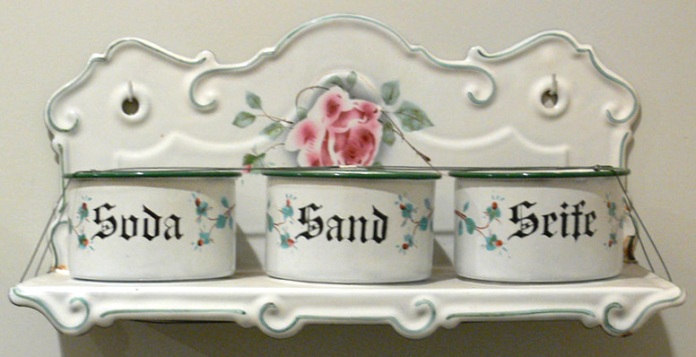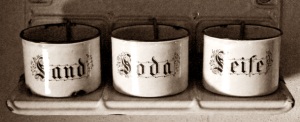
German kitchens used to have a decorative shelf with a set of pots, neat and tidy, filled with three essentials for a clean home: soap, sand, and soda. Although English-speaking countries never had a special storage unit like this, and didn’t think of the “three esses” as a trio, they also made much use of sand and soda as well as soap.

Antique wall-hung shelves with their three containers appeal to collectors in the USA, not just parts of Europe. The most attractive to me are the ones ornamented in folk art style with full-petalled pink roses and curving outlines. Traditional German lettering adds character too.
They all seem to be made of enamelled sheet metal and belong to the first half of the 20th century, or possibly the late 19th too – the heyday of enamelware. If you know when these first came into use please do add a comment. The early 20th/late 19th century dates would match with cleaning and washing methods in that period.
Washing soda in the late 19th century was factory-made and quite affordable. Among other things, it helps with laundry and with taking out stains from wood, and is simple enough to be seen today as a “green” product. Soap, like soda, was quite plentiful by 1900, not too expensive, and was available in powder or flakes suitable for filling a nice enamel pot.

Sand had been a basic cleaning agent for centuries: for scrubbing floors, scouring iron cooking pots, and much more. This is easier to remember in German-speaking countries where the word Scheuersand, meaning scouring sand, is still recognised. Fine sand for cleaning gradually morphed into white abrasive cleaning powders with hygienic-smelling chemicals. There was an intermediate stage with sand and soda scouring mixes. One brand of “sand”, ATA, was remembered with nostalgia by some older people from former East Germany, after it vanished around 1989.

Household advice books from 100 years ago tell us about using the three esses. There’s one in German that recommends mixing soda and sand for cleaning wood – no soap as that makes wood look grey. Use all three for metal utensils but be sparing with the sand or you will damage tinned surfaces. Enamel is best cleaned with a soap and soda mixture, after soaking.
Or you can buy some detergent at the supermarket…..
Photos
Photographers credited in captions. Links to originals here: first big picture, child’s book illustration, sepia photo. More picture info here
My Dutch grandmother had a green enamel shelf with the 3 pots on it Zand, Zeep,Zoda I think it said. Green with either white or pale yellow rim and writting. One of the 11 kids inherited it. I have since looked for one similar. There are remakes out there but not really what I am looking for.
LikeLike
Hi Terese,
I can send you pictures of mine if you provide your email address please (I can’t seem to see it on the post).
— Jennifer
LikeLike
I have one of these German enamel holders with the three pots (as seen above with pretty pink flowers). I would like to connect with a collector so that I may sell it. Can anyone point me in the right direction?
LikeLike
When adding wall art to the walls, you can use various methods, including a symmetrical and an asymmetrical scheme.
June and July are the most popular months for moving.
Many have enjoyed the colorfulness metal art brings to their rooms and the sturdiness it
can have.
LikeLike
Repeat this process until the yarn covers the entire mesh bag.
You can be assured that the wigs will have a longer
lifespan. When your wig is attached firmly,
you can be rest assured that you will look great and no one will know
you have a wig on.
LikeLike
No matter which of the offset or multiple piece canvas options
you choose for your wall, there can be little doubt that they simply ooze style and appeal
to a huge number of people, which is why they will always be a viable trend in the art world.
The canvas wall art can quickly make a great feeling if you choose appropriate colours.
Ivory, jade and stained glass were common materials for accessories, which
were usually tall and thin and graceful, with gentle curves.
LikeLike
My sister has, what mom called, a dough cupboard. Do you know what was kept in the doors and small drawers? It is such a beauty but we would like more information on how it was utilized. I know that flour was stored in the large rounded drawers. But that’s all.
LikeLike
Thank you for a fascinating post; I confess to being thoroughly intrigued by how household tasks were carried out in our past. I make my own soap and laundry liquid and use soda and vinegar to clean the bathroom but sadly my husband has drawn the line at sand and soda for washing up. Sigh!
LikeLike